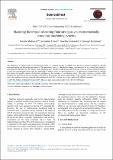| dc.contributor.author | Madanchi, Nadine | |
| dc.contributor.author | Thiede, Sebastian | |
| dc.contributor.author | Gutowski, Timothy | |
| dc.contributor.author | Herrmann, Christoph | |
| dc.date.accessioned | 2021-11-09T18:14:21Z | |
| dc.date.available | 2021-11-09T18:14:21Z | |
| dc.date.issued | 2019 | |
| dc.identifier.issn | 2212-8271 | |
| dc.identifier.uri | https://hdl.handle.net/1721.1/138008 | |
| dc.description.abstract | © 2019 The Authors. Published by Elsevier B.V. This is an open access article under the CC BY-NC-ND license The application of cutting fluids for machining processes is a common practice in industry with the aim to improve productivity through increased cooling and lubricating performance. The application, however, also requires energy and resources for e.g. cutting fluid supply or chip treatment. Alternatively, the strategy of dry machining does not require cutting fluids and therefore claims to be more beneficial in terms of costs and environmental impact than wet machining. In order to assess the actual performance, it is important to comprehensively consider and analyze all possible impacts of alternative strategies on the elements of a machining system. This paper proposes a concept, which integrates the modeling of relevant influences depending on the strategy. The general applicability of the concept is shown within a case study, where the modeling results are compared with experimental results for a turning process and evaluated for different scenarios. | en_US |
| dc.language.iso | en | |
| dc.publisher | Elsevier BV | en_US |
| dc.relation.isversionof | 10.1016/j.procir.2019.01.068 | en_US |
| dc.rights | Creative Commons Attribution-NonCommercial-NoDerivs License | en_US |
| dc.rights.uri | http://creativecommons.org/licenses/by-nc-nd/3.0/ | en_US |
| dc.source | Elsevier | en_US |
| dc.title | Modeling the impact of cutting fluid strategies on environmentally conscious machining systems | en_US |
| dc.type | Article | en_US |
| dc.identifier.citation | Madanchi, Nadine, Thiede, Sebastian, Gutowski, Timothy and Herrmann, Christoph. 2019. "Modeling the impact of cutting fluid strategies on environmentally conscious machining systems." Procedia CIRP, 80. | |
| dc.contributor.department | Massachusetts Institute of Technology. Department of Mechanical Engineering | en_US |
| dc.relation.journal | Procedia CIRP | en_US |
| dc.eprint.version | Final published version | en_US |
| dc.type.uri | http://purl.org/eprint/type/ConferencePaper | en_US |
| eprint.status | http://purl.org/eprint/status/NonPeerReviewed | en_US |
| dc.date.updated | 2020-07-17T17:40:42Z | |
| dspace.date.submission | 2020-07-17T17:40:44Z | |
| mit.journal.volume | 80 | en_US |
| mit.license | PUBLISHER_CC | |
| mit.metadata.status | Authority Work and Publication Information Needed | en_US |
